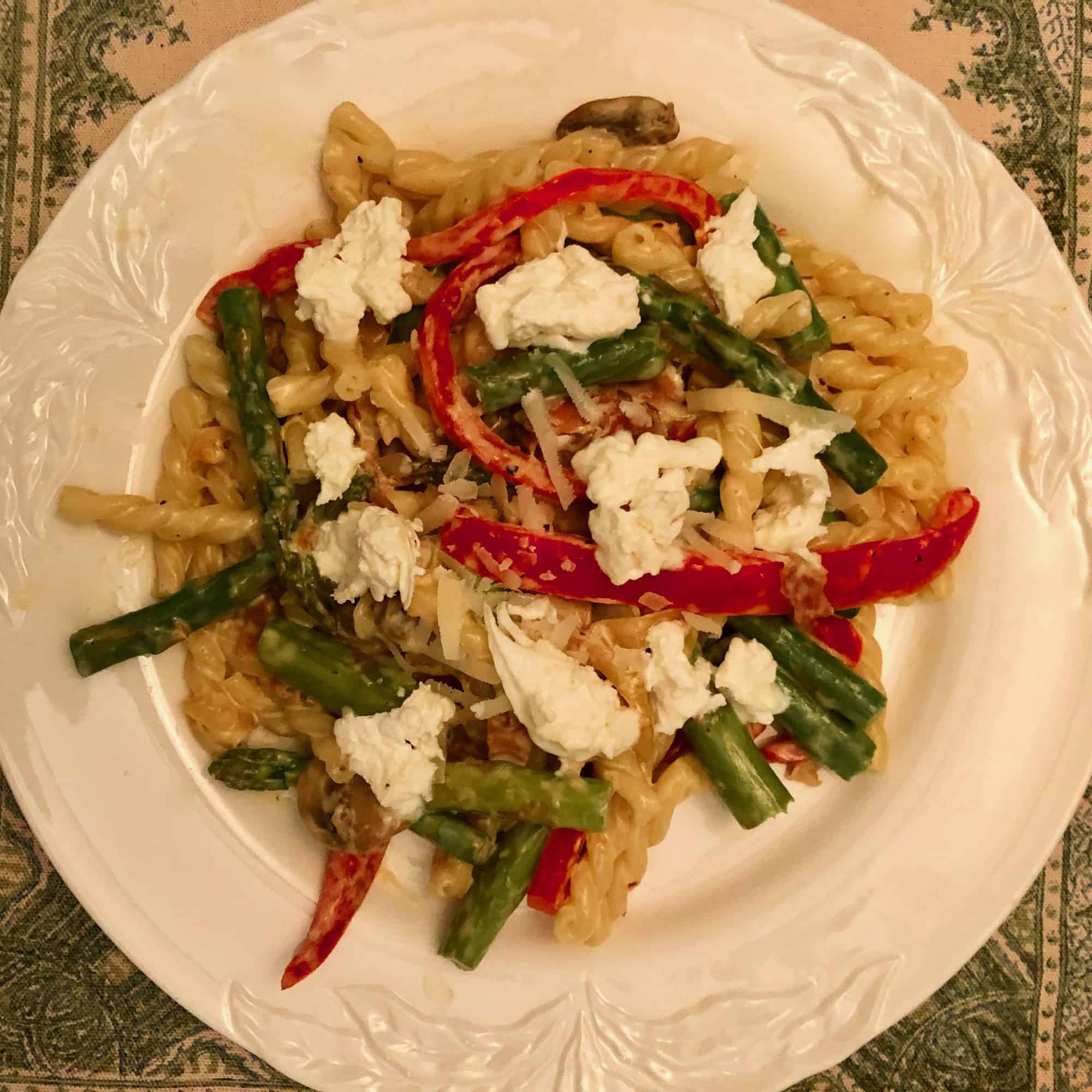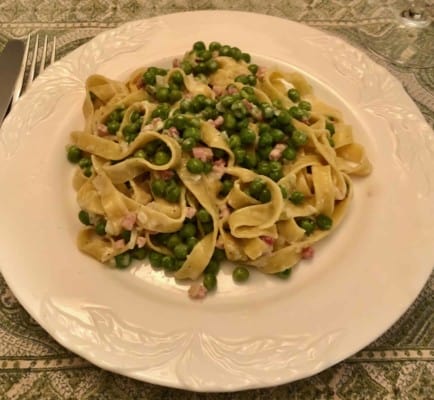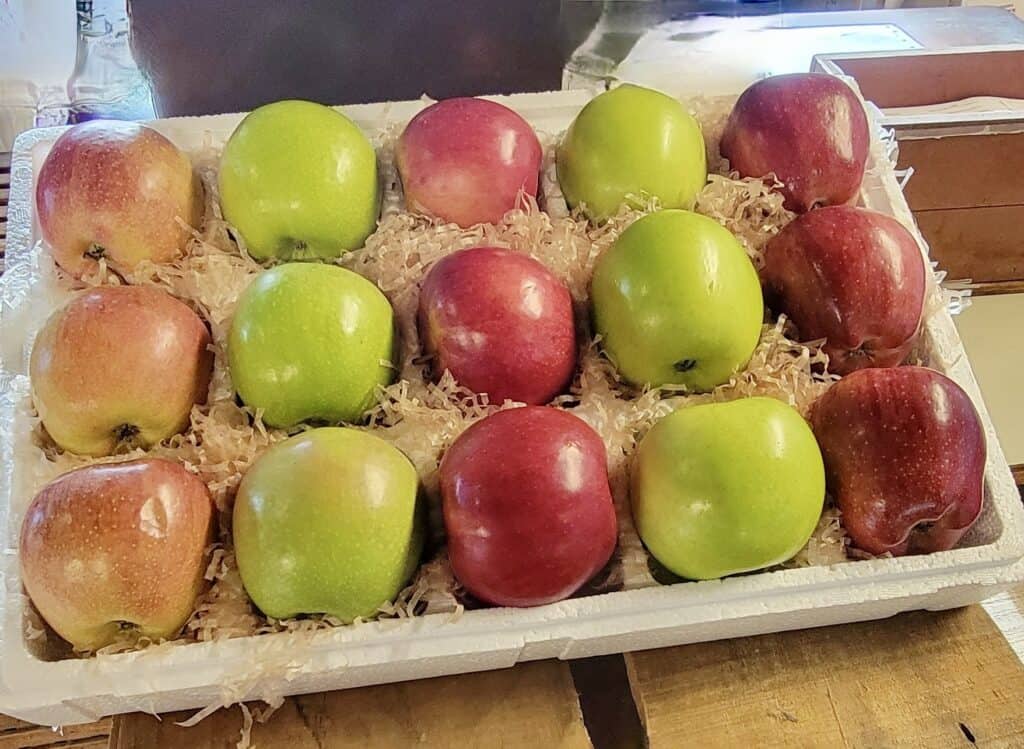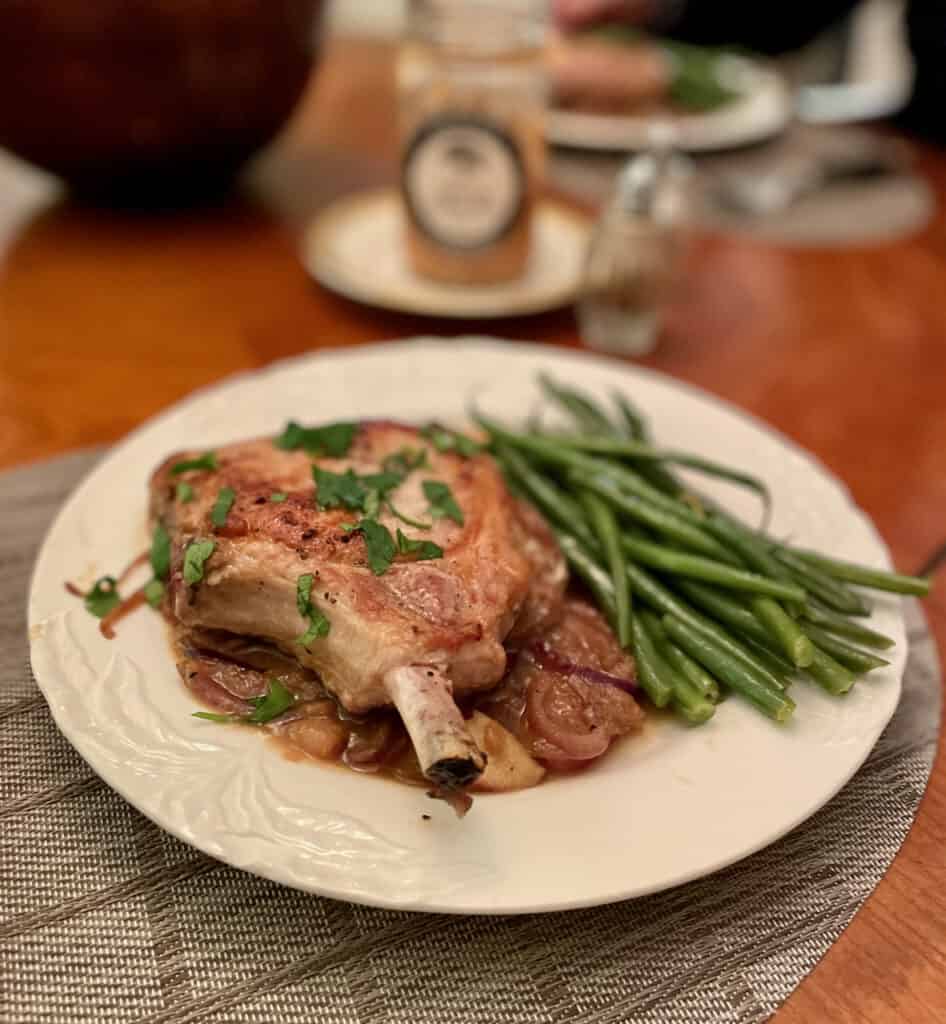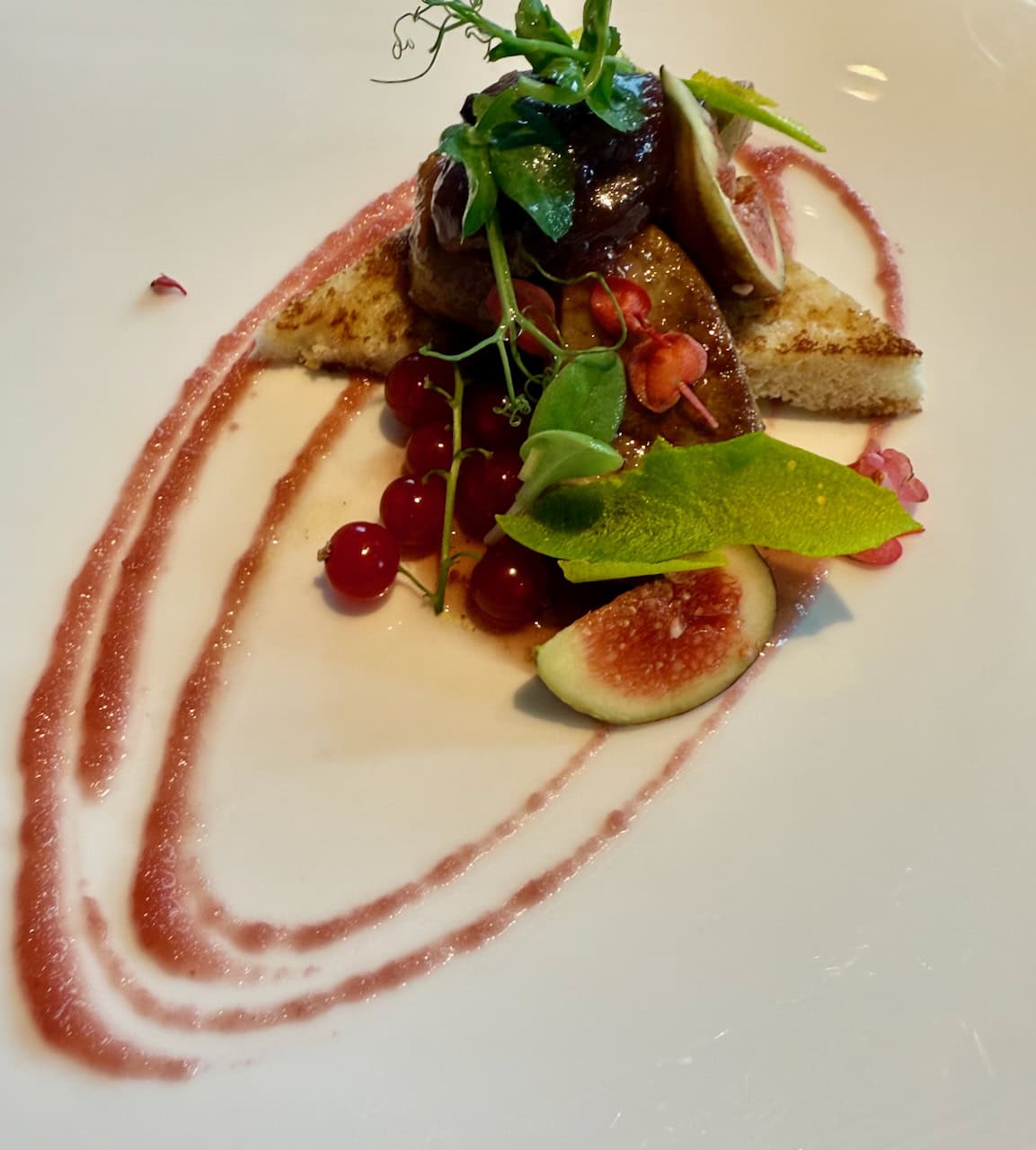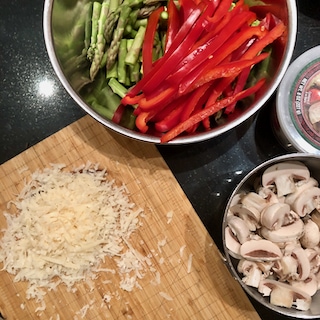 Beloved Italy is beset with a healthcare crisis like no other.
Beloved Italy is beset with a healthcare crisis like no other.
You would have to be living in outer space not to be following the story of the Covid-19 Virus. And if you have an affinity for Italy, I am sure your heart, like mine, is broken over their travails. Imagine shutting down an entire country of over 60 million people. I was thinking about my ‘family’ there and wanted to make something to show my solidarity. I’ll get to my ‘family’ connection further on in this story. But first I wanted to share my Solidarity pasta with you. The Italian flag is tricolor banner and called “Il Tricolore” of green and red and white. So that was my starting off point.
A Pasta Sauce I made to salute my friends and family in Italy.
Like all pasta dishes, it’s not at all complicated. While the pasta cooks, a bed of 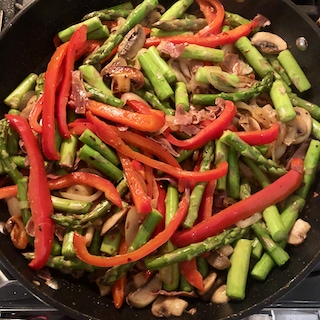 onion, garlic, and mushrooms cook in a large skillet. The green Asparagus and Red Pepper are then added. I chose to add Prosciutto because nothing reminds more of Italy and it gives such a wonderful salty taste to any sauce. Then in went the cream, the obligatory Parmigiano and, because we love a kick, some red pepper chili flakes. I chose Gemelli pasta because cream sauce almost inevitably finds its way into the spiral-shaped pasta. Gemelli means ‘twins’ in Italian. It’s a bit of a misnomer because it’s actually not twin tubes twisted around each other but rather a single S-shaped strand that’s twisted to make a spiral. Fusilli, farfalle, macaroni, penne, rigatoni, and ziti will all work. And finally for the full Il Tricolore effect, I topped the finished dish with pure white Burrata fresh Mozzarella. The recipe follows this story:
onion, garlic, and mushrooms cook in a large skillet. The green Asparagus and Red Pepper are then added. I chose to add Prosciutto because nothing reminds more of Italy and it gives such a wonderful salty taste to any sauce. Then in went the cream, the obligatory Parmigiano and, because we love a kick, some red pepper chili flakes. I chose Gemelli pasta because cream sauce almost inevitably finds its way into the spiral-shaped pasta. Gemelli means ‘twins’ in Italian. It’s a bit of a misnomer because it’s actually not twin tubes twisted around each other but rather a single S-shaped strand that’s twisted to make a spiral. Fusilli, farfalle, macaroni, penne, rigatoni, and ziti will all work. And finally for the full Il Tricolore effect, I topped the finished dish with pure white Burrata fresh Mozzarella. The recipe follows this story:
My time in Italy was unforgettable. And my “family” connection is very much alive.

I spent one of the most consequential years of my life in Italy. A Senior at the Rhode Island School of Design, I was part of their European Honors Program in Rome. There were 28 of us. We were practically fresh off the boat when we were taken to Umbria or Tuscany to spend a month with an Italian family. We’d studied Italian for a year. This was to be real-world total immersion in the language. It was considerably before the world took up English as its lingua franca. Considerably fewer people spoke English than do today. So it was that I found myself in Assisi. A gorgeous blond girl about my age met me at the bus that had brought me to town. The Minciotti family had agreed to take in a student for a month. Little did we know, they’d taken in a friend for life.
All about my family and their glorious home.

The Famiglia Minciotti lived in a glorious Palazzo in the upper part of Assisi directly opposite the Cathedral of San Rufino. It had belonged to the family since the 1850s, part of the dowry of one Countess Giulia Cilieni Nepis, whose father was a famous painter in Assisi. He was one of the first artists to use lithography. Countess Giulia and Salvatore Minciotti Sr. had a very large family of 8 children. But only one of them, Edoardo, married and had an only son. Three of the 8 took religious vows. It was a great point of pride in the Family that one of the three became the Prioress of Assisi’s Benedictine Monastery who hid many Jewish families in her convent during the dark days of fascism. There’s even an American movie about Prioress Matilde Minciotti called “Assisi Underground”.
My Passion for the Italian language started at the dinner table.
The house was wonderful, the family even more so. I think that perhaps the Minciottis imagined their two children, Sofia and Edoardo, might pick up a little English from their Canadian charge. Instead, I was passionate about speaking Italian. And the family dinner table where Nonna, their grandmother, and Nimesia, a marvelous family retainer who may have been about 90, joined the Minciotti children and their parents at an often boisterous table. I made tons of mistakes in Italian. I once thought I was asking to smell something brought to the dinner table. Instead, I had asked if I could ‘puzzare’ the dish. Puzzare means ‘to stink’. At the end of a month with the family, with not a dry eye in the house, I went back to Rome. But that was hardly the last of the Minciottis. Sofia’s fiancé, a young journalist named Mario LaFerla lived in Rome. He invited me to many movie premieres there and I saw the family on many occasions throughout the year.
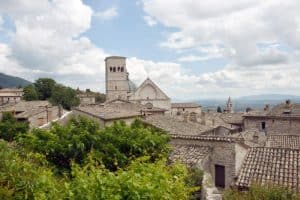
You too can stay with the Minciottis in Assisi.
Years passed and the Christmas cards kept coming until one year they didn’t. Vittoria Minciotti, the mother of the two children, became ill. I lost contact until the advent of Facebook. The new Italian leader of the RISD European Honors Program set up a page that I immediately joined. And almost as immediately, I heard from him and from Edoardo, now a heart surgeon in Gubbio. An assignment took me to Italy and a fantastic reunion. Sofia, now retired from teaching and Mario, who had written some 13 books in the interim, welcomed me to their home in Milano. Our lives had some amazing parallels. Sofia and Mario had a daughter close to my son’s age. Their grandson was just a little older than my own. Edoardo has a much younger stunning daughter. I cannot tell you how much the Family Minciotti means to me. And how my heart goes out to them all in a sad moment in Italy. One more thing, you can stay at Palazzo Minciotti. Edoardo and Sofia have kept the house in beautiful order and fashioned it into four apartments. They can accommodate 2 to 8 people. There’s a splendid three-level terraced garden with wonderful views. And there’s even a swimming pool. Go to http://palazzominciottiassisi.com/en/ and see for yourself. Because one of these days, Italy will be healthy again. And I can’t think of anywhere I would rather be. Here is the recipe for Solidarity Pasta.
Solidarity Pasta with Asparagus, Red Pepper and Burrata
Crisp asparagus and sweet red pepper combine with prosciutto and cream to make a Pasta Sauce that is then dabbed with pure white Burrata in a salute to the Italian flag.
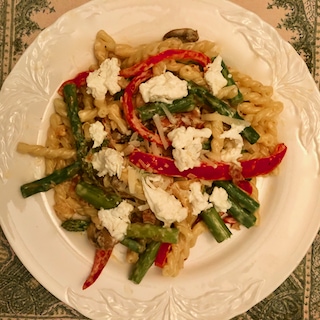
Ingredients
- 8 ounces of Gemelli or other pasta
- 1 tablespoon olive oil
- 1/2 large onion, sliced
- 2 garlic cloves, minced
- 2 cups sliced mushrooms
- 4 ounces thinly sliced prosciutto, cut into strips
- 1 red pepper, cored and cut into ¼ inch strips
- 1 pound asparagus, trimmed and cut into 1-in. pieces
- 1 1/4 cups heavy whipping cream
- About 1/4 cup grated parmesan cheese
- 1/2 teaspoon pepper
- 1/2 teaspoon red pepper chili flakes
- 1 boule of Burrata fresh Mozzarella Cheese
Directions
- Step 1 Cook pasta according to package directions. Drain and return to pot.
- Step 2 Meanwhile, heat oil in a large frying pan over medium-high heat. Cook onion, garlic, and mushrooms until fragrant, about 2 minutes. Add prosciutto and asparagus and red pepper and cook until asparagus is bright green, about 2 minutes. Add cream, 1/4 cup cheese, the pepper, and chile flakes. Reduce heat to simmer and cook until sauce has thickened, about 4 minutes.
- Step 3 Pour sauce with vegetables over pasta and toss to coat. Dot the top of the pasta with burrata cheese. Serve at once with some crusty peasant-style bread.
